How to Replace a Toilet Fill Valve in 15 Minutes
Last Updated on August 1, 2023 by toilethaven
What is a fill valve?
A toilet fill valve is probably the most important part of a toilet tank. It is responsible for filling the toilet tank with water after every flush.
Toilet fill valves are normally installed on the left-hand side of the toilet tank. A water supply line is then connected to the fill valve from the underside of the tank.
On the inside of the toilet tank, the fill valve is connected to the toilet float and the overflow tube through the refill tube. Old toilets have a float ball attached to the fill valve via a lever, while modern toilets have a float cup/cylinder directly attached to the fill valve’s vertical body.
To replace a toilet fill valve, start by turning off the water supply, flush the toilet then disconnect the supply line from the tank. Remove the locknut, unhook the refill tube from the overflow tube, and lift it out. Adjust the length of the new fill valve, slide it in, and secure it with the locknut. Connect back the water and hook the refill tube to the overflow tube.
How to Replace a Toilet Fill Valve
Replacing a toilet fill valve is a simple task and should take only 15 minutes if you already have the new fill valve. These are the only materials you will need:
- New fill valve
- Sponge
- Adjustable wrench (optional)
- A small bucket
- Measuring tape
Step 1: Drain the Toilet Tank
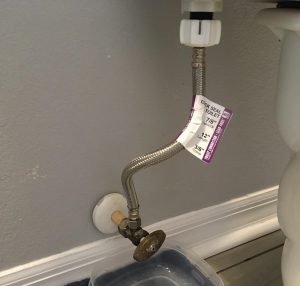
- Start by turning off the water supply to the toilet. The shut-off valve is located on the wall behind the toilet. Turn this valve clockwise.
- If you have the pull/push type of valve, hold the valve handle and pull it outwards.
- Flush the toilet and hold the flushing handle down to remove as much water as possible from the tank.
- Remove the toilet tank lid and place it away in a safe place. You wouldn’t want to break it.
- Use the sponge to soak up the water at the bottom of the tank until it is dry.
Step 2: Remove the old Fill Valve
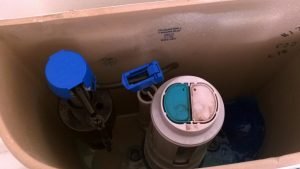
- Disconnect the water supply line from the toilet tank. Use your hand to loosen the coupling, and only use the wrench if it is too tight. Remember to have an empty bucket to collect any water that might still be left in the supply line.
- Remove the fill valve lock nut, which holds the fill valve in place from underneath the tank. Again, remove it with your bare hand before attempting with a wrench.
- Disconnect the refill tube from the overflow tube and lift off the fill valve.
- Take this moment to clean the inside of the tank and especially the area where the new fill valve gasket will sit.
Step 3: Install the New Fill Valve.
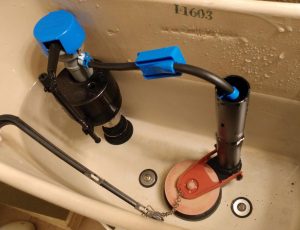
- Inspect the new fill valve’s gasket and make sure it is sitting pretty. This gasket seals the opening where the valve is installed to prevent the tank from leaking from its bottom.
- Place the new fill valve in position but do not tighten it yet.
- Take out the measuring tape and measure the distance between the top cap of the valve and the top of the overflow tube. This distance should be 3 inches.
- Remove the fill valve and adjust the height. Hold the valve body with one hand and use your other hand to turn the threaded shank clockwise or counterclockwise until you get the desired height.
- When the height is properly adjusted, put the fill valve back in position and screw in the locknut from underneath the toilet tank to hold the fill valve firmly in place.
- Connect the water supply line to the new fill valve and hand tighten. Do not use a wrench here.
- Clip the refill tube to the overflow tube. If the refill tube is too long, cut it into size to prevent it from siphoning water from the bowl.
Step 4: Reconnect the Water Supply
- Open the shut-off valve and let the water fill the toilet tank.
- Check if the new fill valve is filling the tank faster, quieter and that the water level in the tank is about ½ inch below the overflow tube.
- Confirm also that no water is running from the tank to the bowl.
- Flush the toilet several times to ensure the new fill valve is performing optimally.
- If you are happy with everything, put the toilet tank lid back on and enjoy your toilet.
And that is how to replace a fill valve in your toilet. If, unfortunately, your toilet is still running after replacing the fill valve, you should consider replacing the toilet flapper or the flush valve. To replace the flush valve, you will need first to remove the toilet tank. In case it comes to that, we have written a very informative post on removing a toilet tank. Read it here. This is only if you have a two-piece toilet.
Toilet Parts Diagram
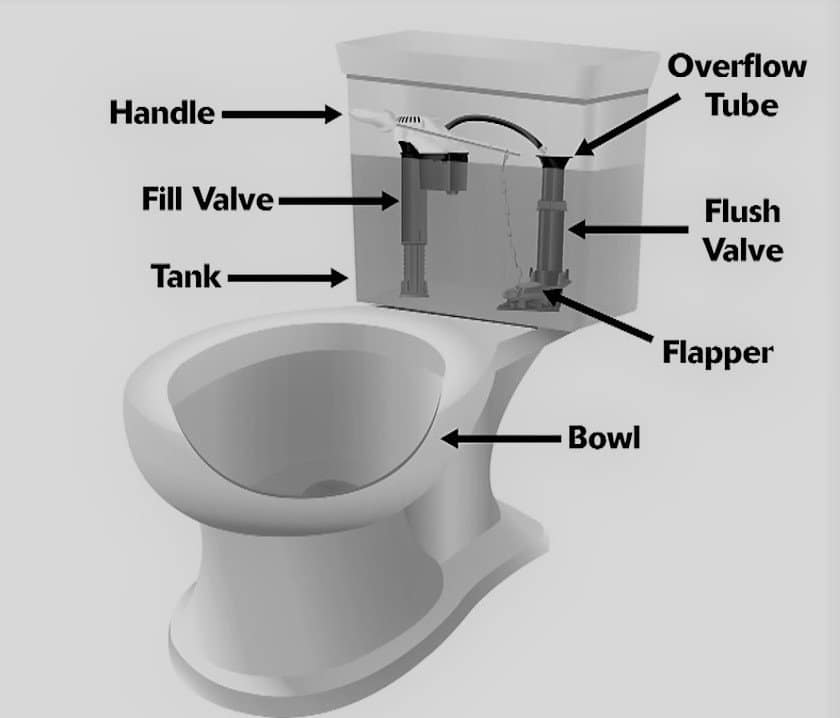
How Do I know if My Toilet Fill Valve is Bad?
The following are the telltale signs that your fill valve has seen better days and will therefore need to be replaced:
- The toilet won’t stop running.
- When the toilet is taking too long to refill.
- The toilet has a weak flush/not flush all the way.
- When the toilet makes a humming/screeching sound.
How a Fill Valve Works
To understand how to replace a fill valve, it is important first to understand how it works. Before you flush the toilet, the toilet tank is normally full of water, the fill valve shut, the flapper is sitting on the flush valve opening, and the toilet float at the top of the tank. This is what happens when you flush the toilet:
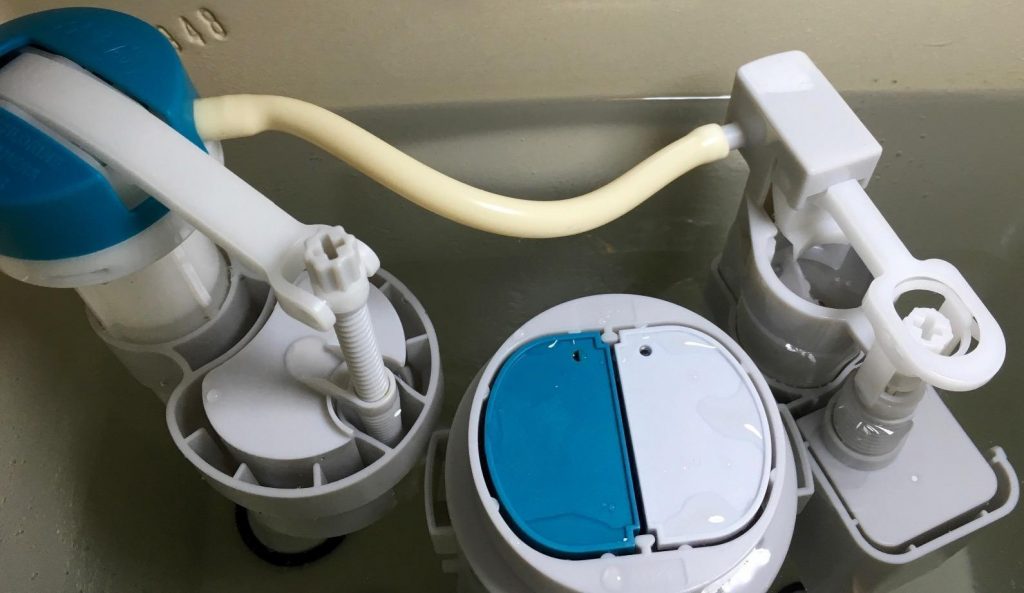
Toilet Flapper
When you push the flushing handle down, the lift chain lifts the toilet flapper off the opening of the flush valve. The water in the tank flows to the toilet bowl through the flush valve for flushing.
After flushing, the flapper sits back on the flush valve opening to allow the toilet tank to refill. Some people prefer to replace the toilet flapper while replacing the fill valve. If you want to replace your flapper, this is how to do it.
Toilet Float
After flushing the toilet, the toilet float moves to the bottom of the tank, opening the fill valve. Water fills the tank, and the float starts to move up gradually. When the float reaches its set height, it stops moving and shuts the fill valve.
Refill Tube
The refill tube is a small tube connected from the fill valve to the overflow tube. After flushing and as the fill valve fills the tank with water, the refill tube sends a small amount of water back to the toilet bowl.
That is the water you see at the bottom of the bowl, which acts as a barrier for preventing sewer gases from coming up into your bathroom.
Overflow Tube.
The overflow tube is a large tube in the toilet tank that acts as the tank’s failsafe. If the fill valve is defective and is continuously filling the tank with water, the overflow tube sends the excess water back to the toilet bowl to prevent overflowing of the toilet.
When you have a toilet that won’t stop running, the toilet flapper is not sealing, or the fill valve is defective, continuously sending water down to the bowl.
Water Supply Line
The water supply line is a tube that runs from the shut-off valve to the toilet tank. It is specifically connected to the fill valve and supplies water as and when needed.
FAQs
1. Are toilet fill valves universal?
Yes. Modern toilet fill valves, which use a float cup/cylinder, can be installed on any toilet. They are easy to install, and their heights can be adjusted to fit any toilet tank.
2. Which is the best toilet fill valve?
Apart from the one made by your toilet manufacturer, Fluidmaster’s and Korky toilet fill valves are among the best in the market.
3. How much does it cost to replace a toilet fill valve?
A new toilet fill valve costs under or about 20 dollars. A plumber will, however, charge you between 70 and 150 dollars to replace the fill valve.
4. How long does a toilet fill valve last?
In areas where water has lots of mineral deposits, the toilet fill valve will not last as longer as in areas with clean water. How long the fill valve lasts also depends on its quality and the traffic the toilet gets daily. On average, toilet fill valves last for 5 years.
5. Can you fix a toilet fill valve?
If the fill valve is old, you should consider replacing it. If, however, the fill valve is fairly new, then you can try and fix it. Sometimes it is just mineral deposits trapped inside, which are easy to remove.
6. What is the difference between a toilet fill valve and a flush valve?
A toilet fill valve is a toilet part found in the toilet tank that fills the tank with water after every flush. On the other hand, the flush valve is a 2-4 inch wide opening at the bottom of the toilet tank where the water leaves the tank and flows to the toilet bowl during flushing.